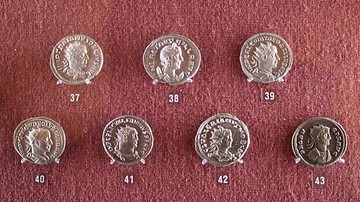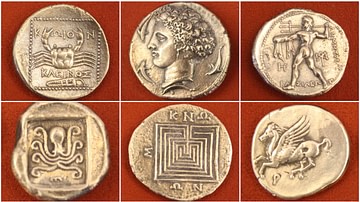
Numismatics the study of coinage, and is a wonderfully useful tool in the archaeologist's and historian's toolbox. One of the best things for an archaeologist to find while digging is a coin. The reason is simple; it can instantly provide some date for the layer they are digging. Additionally, coins provide information for trade, economy, social organisation, mythology, ideologies, personages, leadership, military, important events, and the list goes on.
Parts of coins
To analyse ancient coinage there are some terms that one must first understand:
The Obverse: The obverse is the heads side or the front of the coin. Roman Imperial coins usually display the head of the Emperor or a significant relative. It can be difficult to identify the obverse on a Greek coins because of the images depicted.
The Reverse: The reverse is the opposite side of the coin to the obverse. It is the tails side or back of the coin. Roman Imperial coins usually display some sort of propaganda on the reverse, while Republican coins depict a theme glorifying a certain ancestor. Again with Greek coins it can be more difficult to identify.
Legend: This refers to the inscription on the coin excluding mint characters. It typically runs round the exterior edge of the coin but there are exceptions.
The legend can contain abbreviations, particularly on Roman coins, which are significant to the analysis of the coins. Some of the most common are:
AVG = Augustus
C or CAES = Caesar
IMP = Imperator/Commander
PERP or PP = Perpetuus/Continuous
P F = Pius Felix/dutiful to the gods, the state or one's family
P M = Ponifex Maximus
P P = Pater Patriae/Father of his country
S C = Senatus Consulto/by degree of the state
S P Q R = Senatus Populusque Romus/The Roman Senate and People
Field: The field is a flat undecorated area which sometimes contains mint or control marks, which are a sequence of letters or symbols indicating who produced the coins.
Exergue: The exergue is a space at the bottom of the reverse which often separated from the image by a line. Sometimes this space houses part of the legend or a mint mark.
Type: The central design on the reverse which is generally surrounded by the legend and on top of the exergue.
Important Terms to Remember when Analysing:
AE: AE is often found in the description of coins and is an abbreviation meaning that the coin is of a base metal or alloy (eg. Copper or bronze). When used alongside a number it refers to the size of the coin. This measurement is done in millimetres of the diameter of the coin but does not represent the millimetres themselves but a certain category which they belong to. For instance, with Roman coins, AE1 are alloy coins over 25mm and AE2 are 21-25mm etc.
AR: Is an abbreviation indicating that the coin is made of silver derived from the Latin 'argentum' meaning silver.
AU: Is an abbreviation indicating that the coin is made from gold derived from the Latin 'aurum' meaning gold.
Brockage: Refers to a coin which has been mis-struck and the reverse image appears incuse on the obverse of the coin.
Restoration: Refers to an issue of a coin which replicates a previous coin with few minor changes. Often this is to keep the reverence of previously depicted persons by keeping coins in circulation.
Serrated/Serratus: Refers to a coin with a notched edge.
Transverse: Something held at an angle in the image.













